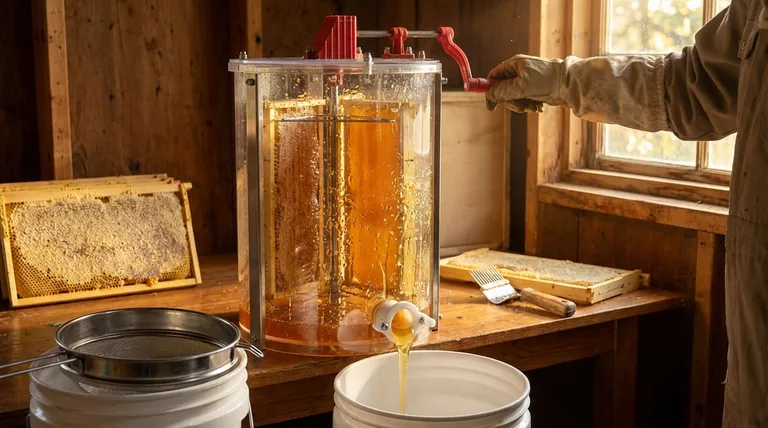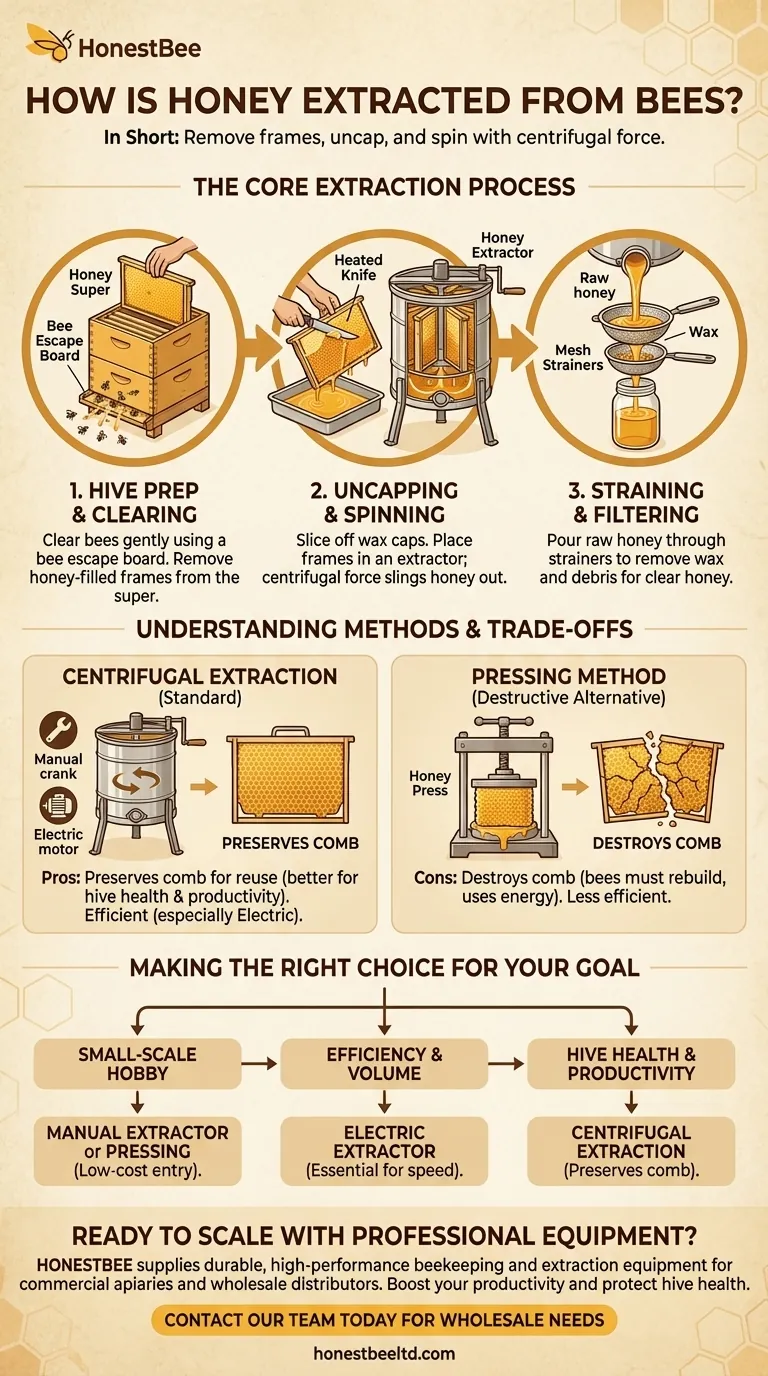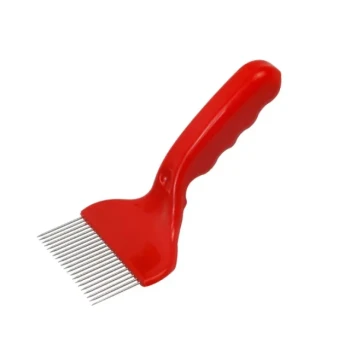In short, honey is extracted by removing honeycomb frames from the hive, scraping the wax caps off the honey cells, and then spinning the frames in a centrifuge called an extractor. This spinning action uses centrifugal force to pull the liquid honey out of the comb without destroying it.
The method of extraction is a critical choice for any beekeeper. While centrifugal force is the standard, the real decision lies in the tools you use and how you prepare the hive, which directly impacts efficiency, honey quality, and the well-being of the colony.

Preparing the Hive for Harvest
Before any honey can be extracted, the bees must be safely and calmly cleared from the honey-filled frames, known as "honey supers." This is a crucial first step.
The Importance of the Honey Super
The honey super is a box placed on top of the main hive body (the brood chamber) specifically for bees to store excess honey. Maintaining a clean and pest-free super is essential for producing high-quality, uncontaminated honey.
Clearing Bees from the Super
A popular and gentle way to clear the supers is by using a bee escape board. This one-way door is placed between the honey supers and the brood chambers. Bees can travel down into the main hive but cannot get back up into the super, clearing it for harvest within 24-48 hours.
The Core Extraction Process
Once the bees are cleared, the frames full of honey can be removed and brought to a clean processing area.
Step 1: Uncapping the Comb
Bees seal each cell of finished honey with a fresh layer of beeswax, called a "cap." The beekeeper must slice these caps off, typically using a special heated knife or a serrated uncapping fork. This exposes the liquid honey underneath.
Step 2: Spinning in an Extractor
The uncapped frames are placed into a honey extractor, which is a large drum that spins the frames at high speed. The centrifugal force slings the honey out of the cells and onto the inner wall of the drum, where it drips to the bottom.
Step 3: Straining the Honey
The raw honey collected at the bottom of the extractor contains bits of beeswax and other hive particles. It is then poured through a series of strainers or filters to remove this debris, resulting in the clear honey you see in a jar. Sometimes, the honey is gently warmed in a water bath to make it flow more easily for straining.
Understanding the Methods and Trade-offs
The standard centrifugal extractor is not the only option, and the choice has significant consequences for both the beekeeper and the bees.
Centrifugal Extraction: Manual vs. Electric
Honey extractors come in two main types. Manual extractors require the beekeeper to turn a crank to spin the frames and are well-suited for hobbyists with only a few hives.
Electric extractors automate the spinning process. They are far more efficient and essential for larger-scale or commercial operations, saving significant time and labor.
The Pressing Method: A Destructive Alternative
Another technique is the pressing method. Instead of spinning, the entire honeycomb is cut out of the frame and crushed in a honey press. This squeezes the honey out of the wax.
The major downside is that this method destroys the comb. Bees expend enormous energy creating wax comb, so preserving it with an extractor allows them to refill it much faster, leading to a more productive hive. Pressing forces the bees to rebuild the entire structure from scratch.
Making the Right Choice for Your Goal
Your approach to extraction should align with the scale of your operation and your beekeeping philosophy.
- If your primary focus is a small-scale hobby: A manual extractor or even the pressing method can be a low-cost entry point into harvesting your own honey.
- If your primary focus is efficiency and volume: An electric extractor is a necessary investment to process honey from multiple hives quickly.
- If your primary focus is hive health and productivity: Centrifugal extraction (either manual or electric) is superior because it preserves the bees' drawn-out comb for reuse.
Ultimately, choosing the right extraction method is about balancing your resources with the goal of harvesting honey efficiently while respecting the immense work of the bees.
Summary Table:
| Step | Process | Key Tool | Benefit |
|---|---|---|---|
| 1 | Clearing the Hive | Bee Escape Board | Gently removes bees from honey supers |
| 2 | Uncapping the Comb | Heated Knife or Fork | Exposes honey without damaging comb |
| 3 | Spinning the Frames | Honey Extractor (Manual/Electric) | Uses centrifugal force to extract honey |
| 4 | Straining & Filtering | Mesh Strainer | Removes wax debris for pure, clear honey |
Ready to scale your honey harvest with professional-grade equipment?
HONESTBEE supplies durable, high-performance beekeeping supplies and extraction equipment to commercial apiaries and beekeeping equipment distributors through our wholesale-focused operations. Whether you need reliable manual extractors for a growing operation or efficient electric models for large-scale harvesting, we provide the tools to maximize your yield and protect your hive's health.
Contact our team today to discuss your wholesale needs and discover how our equipment can boost your productivity.
Visual Guide

Related Products
- HONESTBEE 3-Frame Manual Acrylic Honey Extractor
- HONESTBEE 72 Frame Industrial Electric Honey Extractor for Beekeeping
- Electric 8 Frame Honey Spinner Extractor Equipment for Beekeeping
- electric honey extractor honey centrifuge 3 frame honey extractor stainless steel honey frame extractor
- 40 Frame Commercial Electric Honey Extractor for Beekeeping
People Also Ask
- How do you manually extract honey? Choose the Best Method for Your Hive
- How to extract honey by hand? A Guide to Crush & Strain vs. Manual Extractors
- What size honey extractor do I need? Match Frame Capacity to Your Hives for Maximum Efficiency
- What is a fun and easy alternative to using a honey extractor for harvesting honey? Try the Crush and Strain Method
- What machines are needed in beekeeping besides basic tools? Scale Your Honey Harvest Efficiently



















